Abstract
Chlorine and chlorine dioxide (ClO2), common disinfecting and bleaching chemicals used in the food industry, are potent oxidizing and chlorinating agents. Unfortunately, little is known about the nature of the reactions of chlorine with organic food constituents. This presentation reviews published information concerning the reactions of chlorine gas (Cl2[g]), aqueous chlorine, and ClO2 with model food compounds, the fate of chlorine during the chlorination of specific food products, and the potential toxicity of the reaction products. Fatty acids and their methyl esters react with chlorine with the degree of incorporation corresponding to their degree of unsaturation. Aqueous chlorine oxidizes and chlorinates lipids and amino acids much more readily than ClO2. Several amino acids are highly susceptible to oxidation and chlorination by chlorine compounds. Reactions of chlorine and ClO2 with several food products, including flour and shrimp, have also been characterized. In one model system, 99% of Cl2(g) either reacted with components of flour or was consumed by oxidation/chlorination reactions. The lipids extracted from the chlorinated flour contained significant amounts of chlorine. Exposure of shrimp to hypochlorous acid (HOCl) solution resulted in significant incorporation of chlorine into the edible portion. Although significant quantities of chlorine can be incorporated into specific model compounds and food products, the health risks associated with exposure to chlorinated organic products are unknown. Preliminary studies using the Ames Salmonella/microsome mutagenicity assay indicate that the reaction products from mixtures of aqueous chlorine and various lipids or tryptophan are nonmutagenic. Nevertheless, additional studies are warranted, so that the toxicological significance of these reaction products can be understood more fully.
Full text
PDF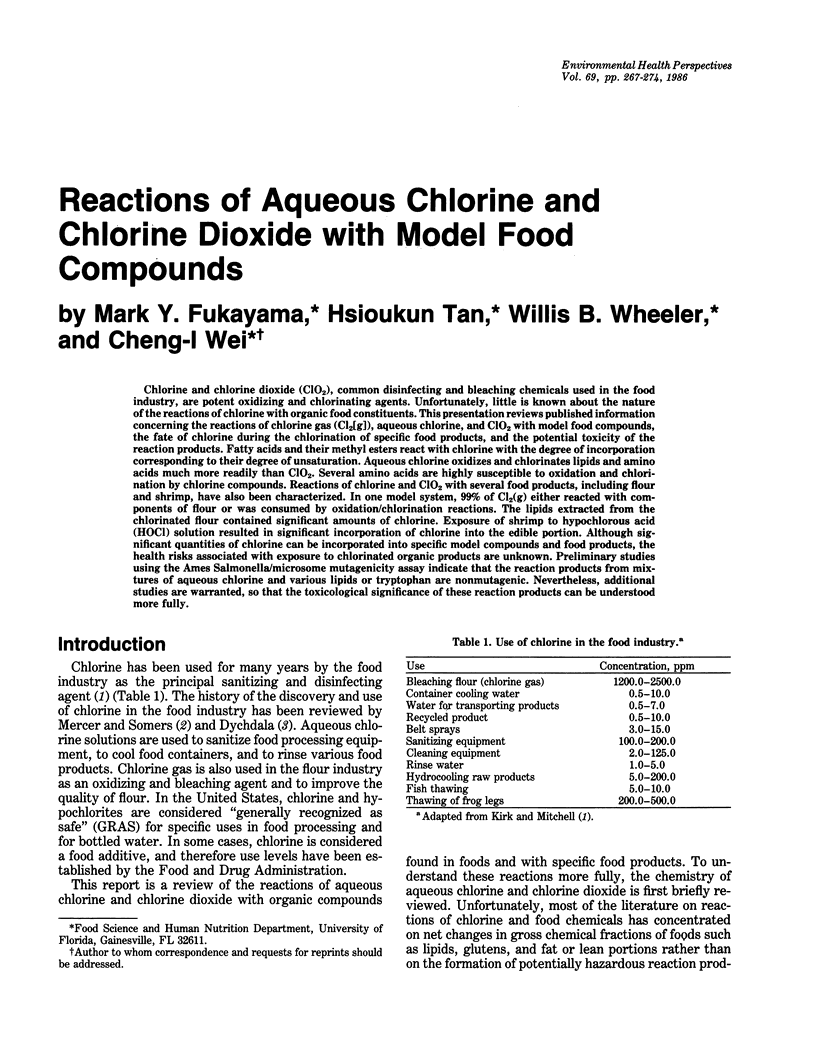
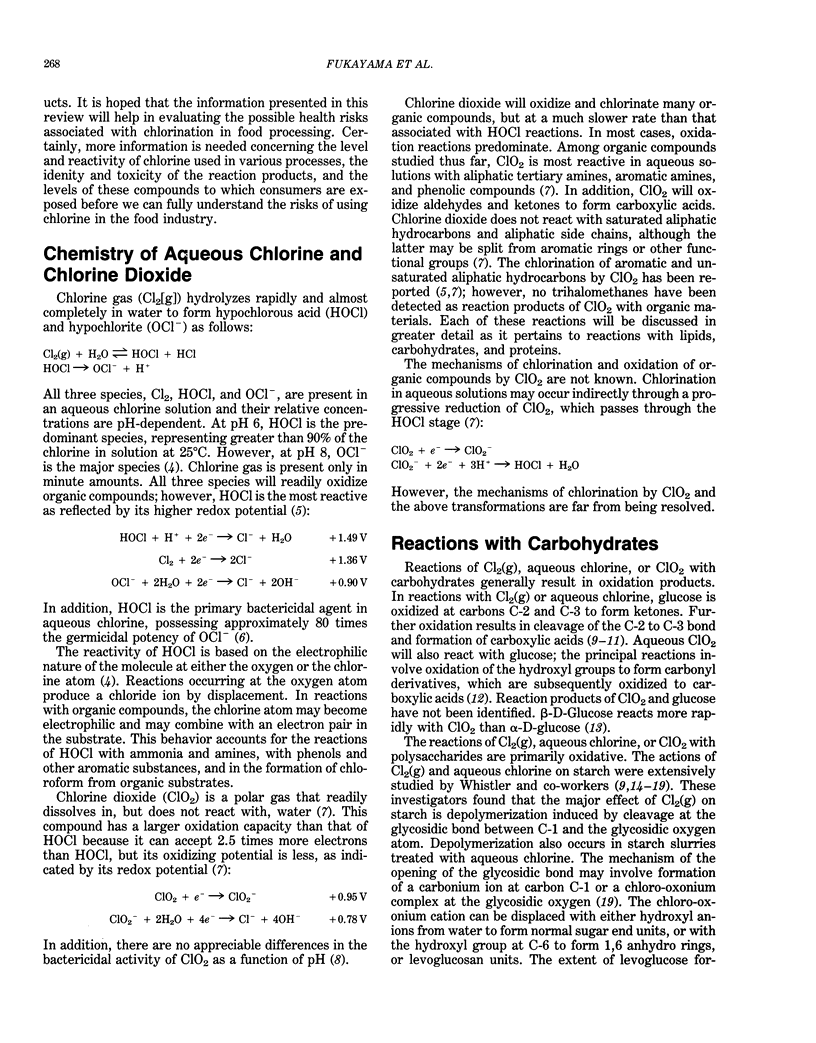
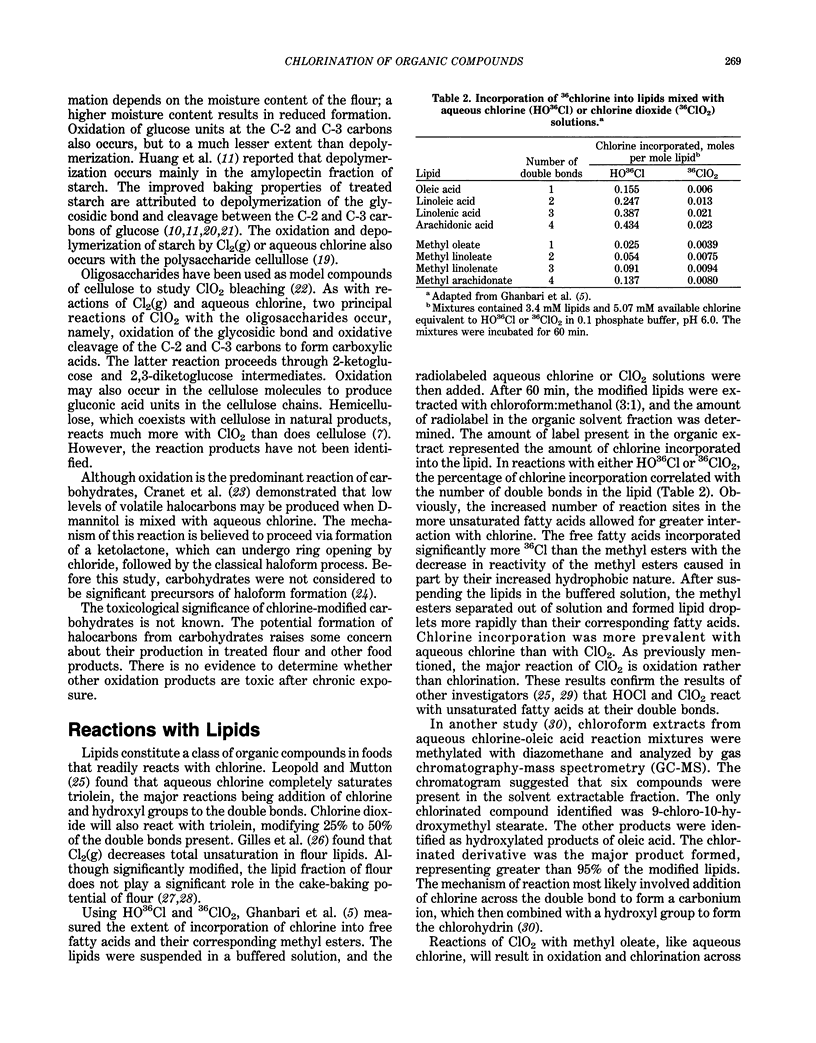
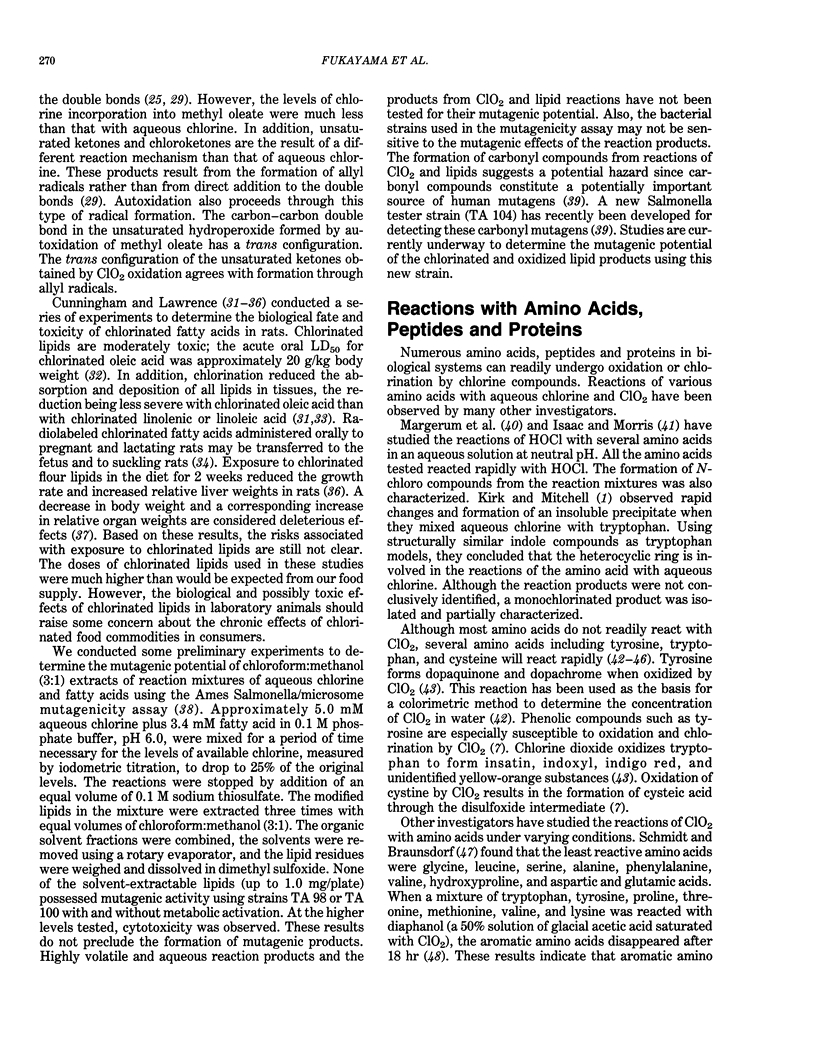
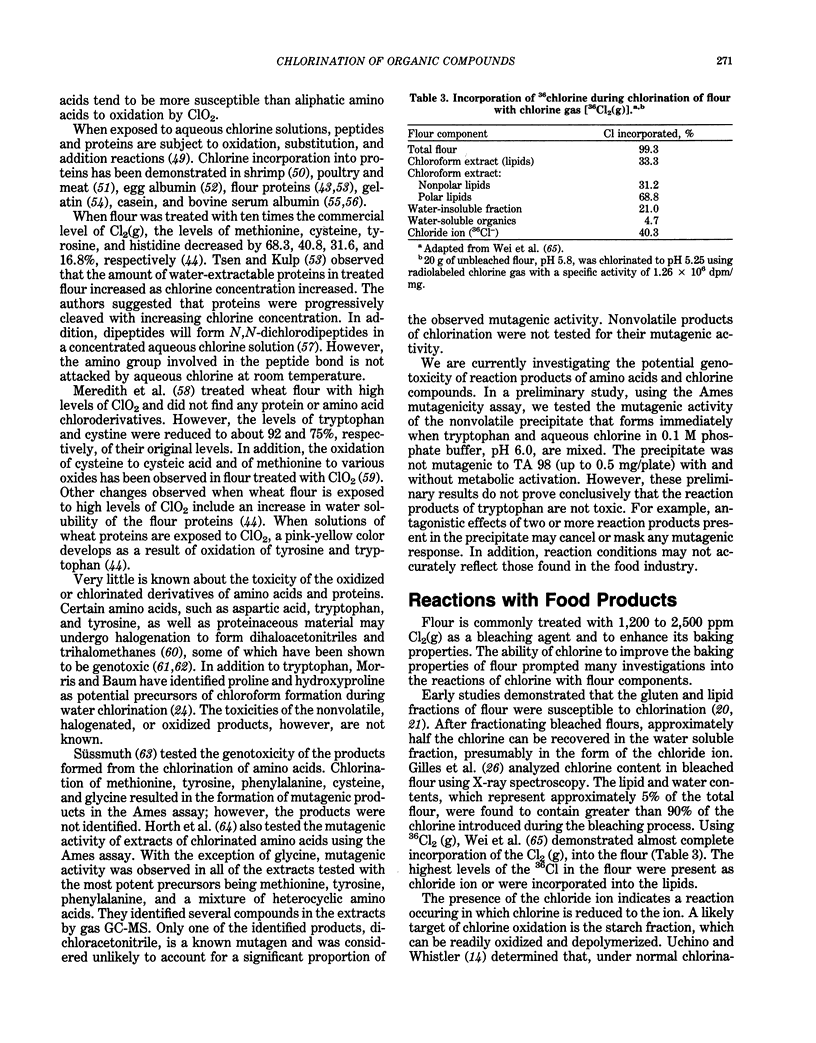
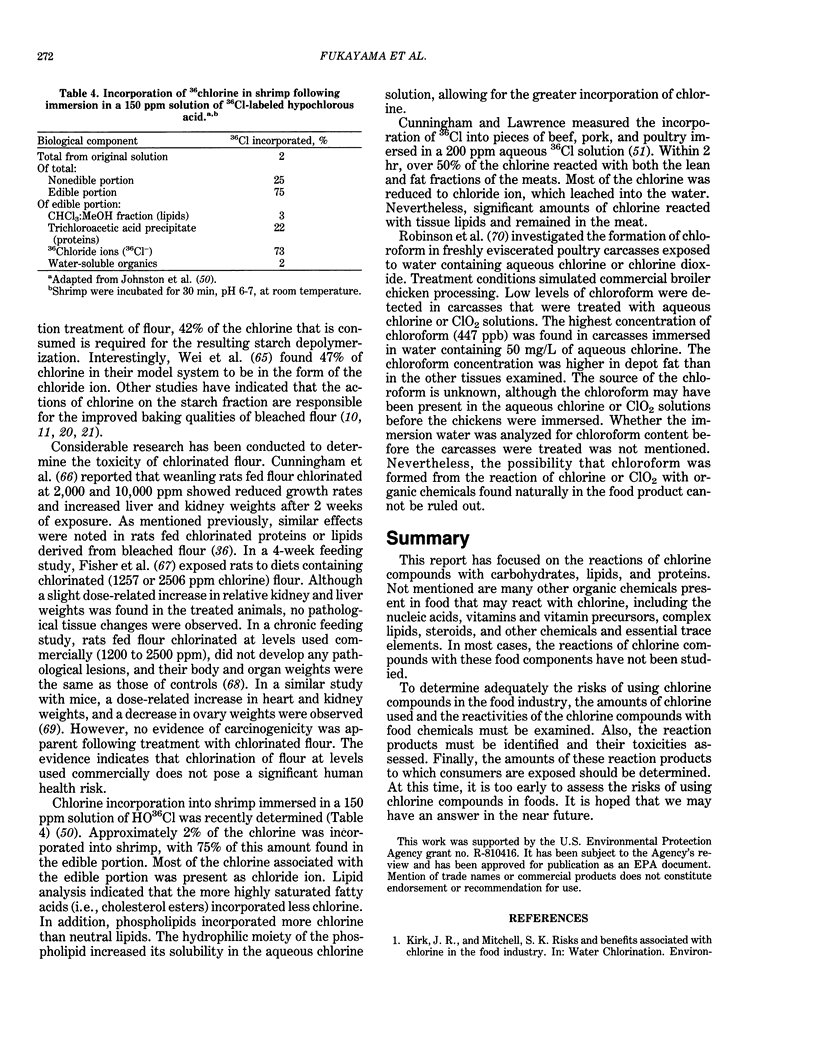
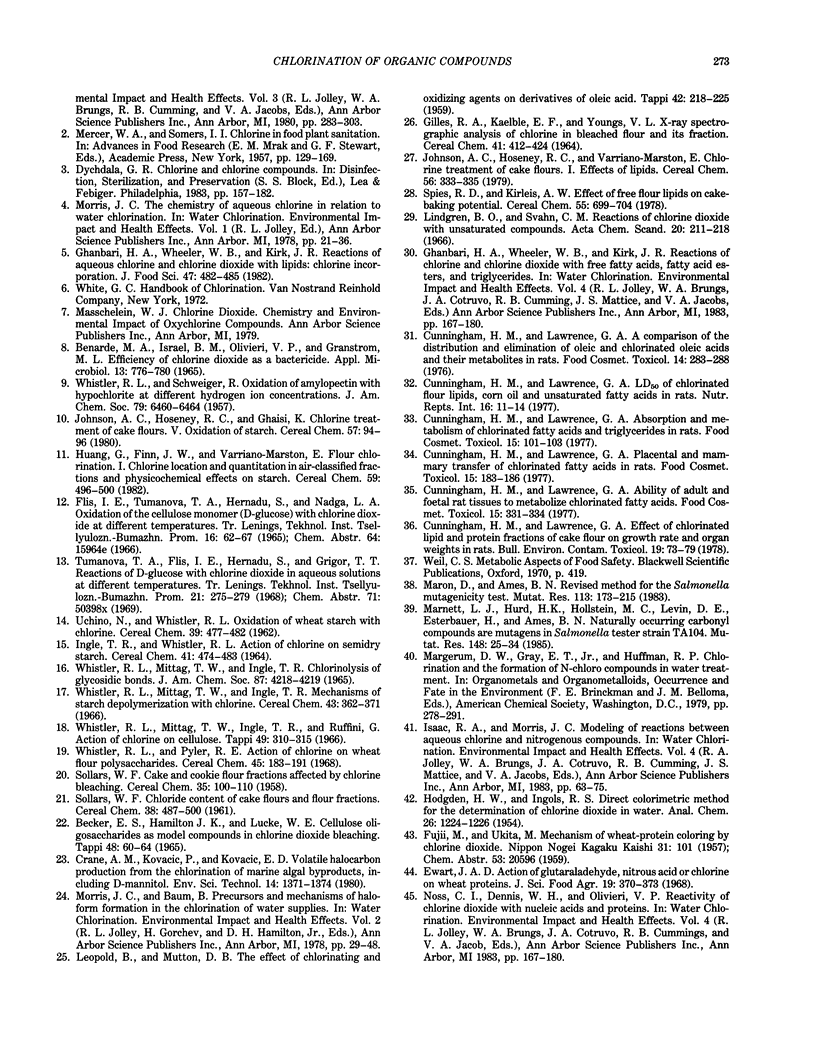
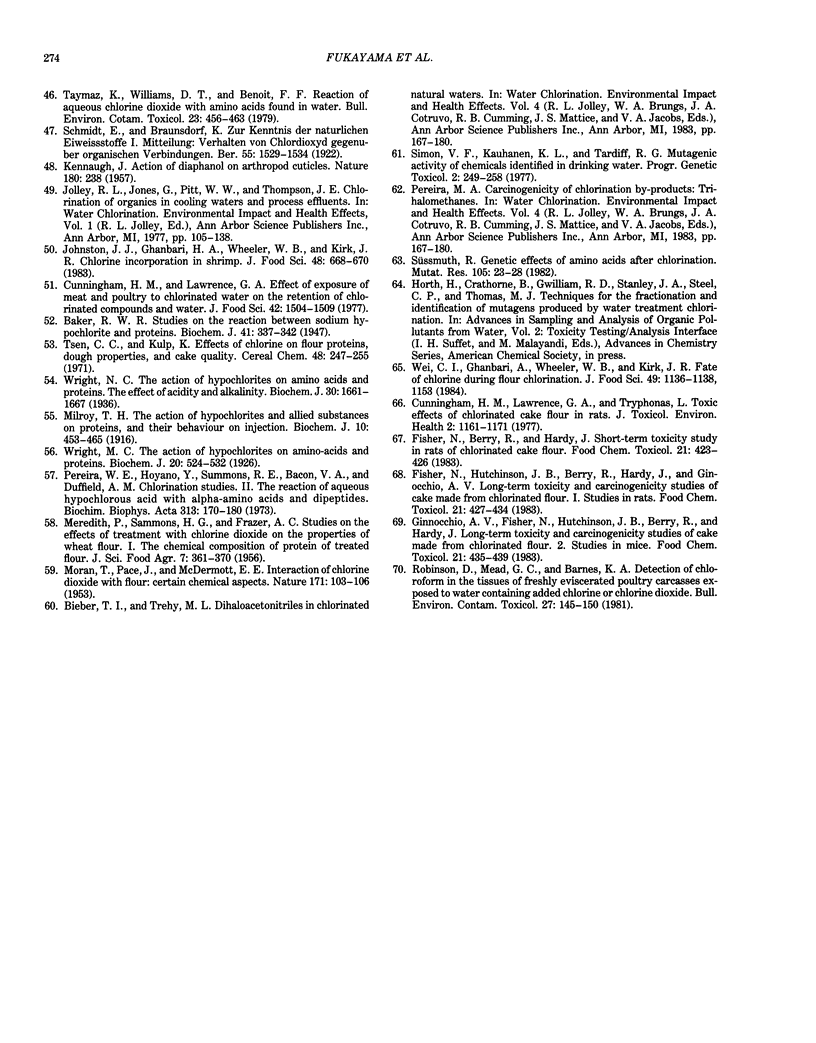
Selected References
These references are in PubMed. This may not be the complete list of references from this article.
- BROCADES ZAALBERG A., VOS O., BEKKUM VAN D. W. Surviving rat skin grafts in mice. Nature. 1957 Aug 3;180(4579):238–239. doi: 10.1038/180238b0. [DOI] [PubMed] [Google Scholar]
- Baker R. W. Studies on the reaction between sodium hypochlorite and proteins: 1. Physico-chemical study of the course of the reaction. Biochem J. 1947;41(3):337–342. [PMC free article] [PubMed] [Google Scholar]
- Benarde M. A., Israel B. M., Olivieri V. P., Granstrom M. L. Efficiency of chlorine dioxide as a bactericide. Appl Microbiol. 1965 Sep;13(5):776–780. doi: 10.1128/am.13.5.776-780.1965. [DOI] [PMC free article] [PubMed] [Google Scholar]
- Cunningham H. M., Lawrence G. A. A comparison of the distribution and elimination of oleic and chlorinated oleic acids and their metabolites in rats. Food Cosmet Toxicol. 1976 Aug;14(4):283–288. doi: 10.1016/s0015-6264(76)80290-8. [DOI] [PubMed] [Google Scholar]
- Cunningham H. M., Lawrence G. A. Ability of adult and foetal rat tissues to metabolize chlorinated fatty acids. Food Cosmet Toxicol. 1977 Aug;15(4):331–334. doi: 10.1016/s0015-6264(77)80205-8. [DOI] [PubMed] [Google Scholar]
- Cunningham H. M., Lawrence G. A. Absorption and metabolism of chlorinated fatty acids and triglycerides in rats. Food Cosmet Toxicol. 1977 Apr;15(2):101–103. doi: 10.1016/s0015-6264(77)80313-1. [DOI] [PubMed] [Google Scholar]
- Cunningham H. M., Lawrence G. A. Effect of chlorinated lipid and protein fractions of cake flour on growth rate and organ weight of rats. Bull Environ Contam Toxicol. 1978 Jan;19(1):73–79. doi: 10.1007/BF01685769. [DOI] [PubMed] [Google Scholar]
- Cunningham H. M., Lawrence G. A. Placental and mammary transfer of chlorinated fatty acids in rats. Food Cosmet Toxicol. 1977 Jun;15(3):183–186. doi: 10.1016/s0015-6264(77)80387-8. [DOI] [PubMed] [Google Scholar]
- Cunningham H. M., Lawrence G. A., Tryphonas L. Toxic effects of chlorinated cake flour in rats. J Toxicol Environ Health. 1977 May;2(5):1161–1171. doi: 10.1080/15287397709529514. [DOI] [PubMed] [Google Scholar]
- Fisher N., Berry R., Hardy J. Short-term toxicity study in rats of chlorinated cake flour. Food Chem Toxicol. 1983 Aug;21(4):423–426. doi: 10.1016/0278-6915(83)90097-2. [DOI] [PubMed] [Google Scholar]
- Fisher N., Hutchinson J. B., Berry R., Hardy J., Ginocchio A. V. Long-term toxicity and carcinogenicity studies of cake made from chlorinated flour. 1. Studies in rats. Food Chem Toxicol. 1983 Aug;21(4):427–434. doi: 10.1016/0278-6915(83)90098-4. [DOI] [PubMed] [Google Scholar]
- Ginocchio A. V., Fisher N., Hutchinson J. B., Berry R., Hardy J. Long-term toxicity and carcinogenicity studies of cake made from chlorinated flour. 2. Studies in mice. Food Chem Toxicol. 1983 Aug;21(4):435–439. doi: 10.1016/0278-6915(83)90099-6. [DOI] [PubMed] [Google Scholar]
- MORAN T., PACE J., MCDERMOTT E. E. Interaction of chlorine dioxide with flour: certain aspects. Nature. 1953 Jan 17;171(4342):103–106. doi: 10.1038/171103a0. [DOI] [PubMed] [Google Scholar]
- Marnett L. J., Hurd H. K., Hollstein M. C., Levin D. E., Esterbauer H., Ames B. N. Naturally occurring carbonyl compounds are mutagens in Salmonella tester strain TA104. Mutat Res. 1985 Jan-Feb;148(1-2):25–34. doi: 10.1016/0027-5107(85)90204-0. [DOI] [PubMed] [Google Scholar]
- Maron D. M., Ames B. N. Revised methods for the Salmonella mutagenicity test. Mutat Res. 1983 May;113(3-4):173–215. doi: 10.1016/0165-1161(83)90010-9. [DOI] [PubMed] [Google Scholar]
- Milroy T. H. The Action of Hypochlorites and Allied Substances on Proteins, and their Behaviour on Injection. Biochem J. 1916 Oct;10(3):453–465. doi: 10.1042/bj0100453. [DOI] [PMC free article] [PubMed] [Google Scholar]
- Pereira W. E., Hoyano Y., Summons R. E., Bacon V. A., Duffield A. M. Chlorination studies. II. The reaction of aqueous hypochlorous acid with alpha-amino acids and dipeptides. Biochim Biophys Acta. 1973 Jun 20;313(1):170–180. doi: 10.1016/0304-4165(73)90198-0. [DOI] [PubMed] [Google Scholar]
- Robinson D., Mead G. C., Barnes K. A. Detection of chloroform in the tissues of freshly eviscerated poultry carcasses exposed to water containing added chlorine or chlorine dioxide. Bull Environ Contam Toxicol. 1981 Aug;27(2):145–150. doi: 10.1007/BF01611000. [DOI] [PubMed] [Google Scholar]
- Süssmuth R. Genetic effects of amino acids after chlorination. Mutat Res. 1982 Aug;105(1-2):23–28. doi: 10.1016/0165-7992(82)90203-2. [DOI] [PubMed] [Google Scholar]
- Taymaz K., Williams D. T., Benoit F. F. Reactions of aqueous chlorine dioxide with amino acids found in water. Bull Environ Contam Toxicol. 1979 Nov;23(4-5):456–463. doi: 10.1007/BF01769987. [DOI] [PubMed] [Google Scholar]
- Whistler R. L., Mittag T. W., Ingle T. R. Chlorinolysis of glycosidic bonds. J Am Chem Soc. 1965 Sep 20;87(18):4218–4219. doi: 10.1021/ja01096a058. [DOI] [PubMed] [Google Scholar]
- Wright N. C. The Action of Hypochlorites on Amino-Acids and Proteins. Biochem J. 1926;20(3):524–532. doi: 10.1042/bj0200524. [DOI] [PMC free article] [PubMed] [Google Scholar]
- Wright N. C. The action of hypochlorites on amino-acids and proteins. The effect of acidity and alkalinity. Biochem J. 1936 Sep;30(9):1661–1667. doi: 10.1042/bj0301661. [DOI] [PMC free article] [PubMed] [Google Scholar]


